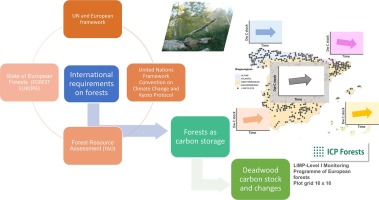当前位置:
X-MOL 学术
›
Forest Ecol. Manag.
›
论文详情
Our official English website, www.x-mol.net, welcomes your feedback! (Note: you will need to create a separate account there.)
Analyzing the dynamics of the deadwood carbon pool in Spain through the European Level I Monitoring Programme
Forest Ecology and Management ( IF 3.7 ) Pub Date : 2020-05-01 , DOI: 10.1016/j.foreco.2020.118020 Daniel Moreno-Fernández , Laura Hernández , Isabel Cañellas , Patricia Adame , Iciar Alberdi
Forest Ecology and Management ( IF 3.7 ) Pub Date : 2020-05-01 , DOI: 10.1016/j.foreco.2020.118020 Daniel Moreno-Fernández , Laura Hernández , Isabel Cañellas , Patricia Adame , Iciar Alberdi

|
Abstract Forest deadwood is a key indicator for biodiversity, disturbances and for carbon storage assessments. However, the role of Mediterranean forests in deadwood carbon storage is unclear. In this regard, the European Regulation 2018/841 on the inclusion of greenhouse gas emissions and removals from land use, land use change and forestry in the 2030 climate and energy framework, requires reports by Member States on the average annual net emissions or removals of deadwood carbon. The main purpose of this work is to explore the trends of forest deadwood carbon to clarify the role of Spanish forest as deadwood carbon storage. We also investigate the effect of forest stand, climatic and physiographic variables on the deadwood carbon trends. For the purposes of our study, we used the deadwood data from two cycles of the European large-scale forest condition-monitoring programme Level I, which spanned from 2009 to 2017. Our findings indicate that there is statistical evidence of increments in deadwood carbon stocks in Spain over the last decade. We also identified certain spatial trends of mean annual changes in deadwood carbon: positive increment in the Mediterranean and Macaronesian regions, close to zero in the Atlantic region and negative in the Alpine region. We also found significant and positive relationships between the mean height and basal area on deadwood carbon stocks as well as a bell-shaped relationship between the mean diameter of living trees as a proxy of stand age on deadwood carbon stocks. The European Level I Monitoring Programme emerged as a useful tool to explore the dynamics of deadwood carbon. However, the temporal scheme and the lack of repeated measurements of dasometric inventories preclude forecasting future deadwood carbon stocks under alternative management regimes and climate conditions. In this regard, the deadwood data collected in future cycles, together with the deadwood data from the National Forest Inventory plots may allow the development of prediction models and therefore fulfill the international requirements on Member States for deadwood forecasts at national scale for the 2021 to 2030 period.
中文翻译:

通过欧洲一级监测计划分析西班牙枯木碳库的动态
摘要 森林枯木是生物多样性、干扰和碳储存评估的关键指标。然而,地中海森林在枯木碳储存中的作用尚不清楚。在这方面,关于将土地利用、土地利用变化和林业的温室气体排放和清除纳入 2030 年气候和能源框架的欧洲法规 2018/841 要求成员国报告枯木碳。这项工作的主要目的是探索森林枯木碳的趋势,以阐明西班牙森林作为枯木碳储存的作用。我们还调查了林分、气候和自然地貌变量对枯木碳趋势的影响。为了我们的研究目的,我们使用了 2009 年至 2017 年欧洲大规模森林状况监测计划 I 级两个周期的枯木数据。我们的研究结果表明,有统计证据表明过去十年西班牙的枯木碳储量有所增加。我们还确定了枯木碳年平均变化的某些空间趋势:地中海和马卡罗尼西亚地区为正增量,大西洋地区接近零,高山地区为负。我们还发现枯木碳库的平均高度和基面积之间存在显着的正相关关系,以及作为枯木碳库林龄代理的活树平均直径之间的钟形关系。欧洲一级监测计划成为探索枯木碳动态的有用工具。然而,时间方案和缺乏对 dasometric 库存的重复测量妨碍了在替代管理制度和气候条件下预测未来的枯木碳储量。在这方面,未来周期收集的枯木数据以及来自国家森林清单图的枯木数据可能允许开发预测模型,从而满足成员国对 2021 年至 2030 年国家范围枯木预测的国际要求时期。
更新日期:2020-05-01
中文翻译:

通过欧洲一级监测计划分析西班牙枯木碳库的动态
摘要 森林枯木是生物多样性、干扰和碳储存评估的关键指标。然而,地中海森林在枯木碳储存中的作用尚不清楚。在这方面,关于将土地利用、土地利用变化和林业的温室气体排放和清除纳入 2030 年气候和能源框架的欧洲法规 2018/841 要求成员国报告枯木碳。这项工作的主要目的是探索森林枯木碳的趋势,以阐明西班牙森林作为枯木碳储存的作用。我们还调查了林分、气候和自然地貌变量对枯木碳趋势的影响。为了我们的研究目的,我们使用了 2009 年至 2017 年欧洲大规模森林状况监测计划 I 级两个周期的枯木数据。我们的研究结果表明,有统计证据表明过去十年西班牙的枯木碳储量有所增加。我们还确定了枯木碳年平均变化的某些空间趋势:地中海和马卡罗尼西亚地区为正增量,大西洋地区接近零,高山地区为负。我们还发现枯木碳库的平均高度和基面积之间存在显着的正相关关系,以及作为枯木碳库林龄代理的活树平均直径之间的钟形关系。欧洲一级监测计划成为探索枯木碳动态的有用工具。然而,时间方案和缺乏对 dasometric 库存的重复测量妨碍了在替代管理制度和气候条件下预测未来的枯木碳储量。在这方面,未来周期收集的枯木数据以及来自国家森林清单图的枯木数据可能允许开发预测模型,从而满足成员国对 2021 年至 2030 年国家范围枯木预测的国际要求时期。


























 京公网安备 11010802027423号
京公网安备 11010802027423号